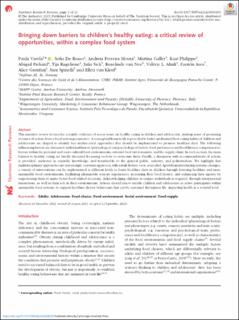| dc.description.abstract | This narrative review revises the scientific evidence of recent years on healthy eating in children and adolescents, making sense of promising avenues of action, from a food system perspective. A conceptual framework is provided to better understand how eating habits of children and adolescents are shaped to identify key multisectoral approaches that should be implemented to promote healthier diets. The following influencing factors are discussed: individual factors (physiological and psychological factors, food preferences and food literacy competencies), factors within the personal and socio-cultural food environments, external food environments, and the supply chain. In each section, the main barriers to healthy eating are briefly discussed focussing on how to overcome them. Finally, a discussion with recommendations of actions is provided, anchored in scientific knowledge, and transferable to the general public, industry, and policymakers. We highlight that multidisciplinary approaches are not enough, a systems approach, with a truly holistic view, is needed. Apart from introducing systemic changes, a variety of interventions can be implemented at different levels to foster healthier diets in children through fostering healthier and more sustainable food environments, facilitating pleasurable sensory experiences, increasing their food literacy, and enhancing their agency by empowering them to make better food related decisions. Acknowledging children as unique individuals is required, through interpersonal interactions, as well as their role in their environments. Actions should aim to enable children and adolescents as active participants within sustainable food systems, to support healthier dietary behaviours that can be sustained throughout life, impacting health at a societal level. | |
